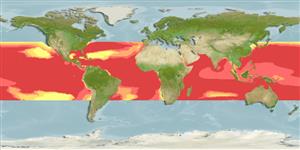>
Stomiiformes (Lightfishes and dragonfishes) >
Gonostomatidae (Bristlemouths)
Etymology: Diplophos: Greek, diploos, = double + Greek, phos = light.
More on author: Günther.
Environment: milieu / climate zone / depth range / distribution range
Écologie
marin bathypélagique; profondeur 0 - 1594 m (Ref. 74511), usually 0 - 800 m (Ref. 4769). Deep-water; 40°N - 30°S
Cosmopolitan. Eastern Atlantic: Portugal (Ref. 4769) south to Gulf of Guinea (Ref. 4463); Namibia and South Africa (Ref. 3991). Northwest Atlantic: Canada (Ref. 5951). Western Atlantic and Indo-Pacific: in tropical and subtropical waters. Eastern Pacific: California Current region (Ref. 35800); Chile (Ref. 9068). South China Sea (Ref.74511).
Taille / Poids / Âge
Maturity: Lm ? range ? - ? cm
Max length : 27.6 cm SL mâle / non sexé; (Ref. 4463); common length : 20.0 cm SL mâle / non sexé; (Ref. 47377)
Description synthétique
Clés d'identification | Morphologie | Morphométrie
Épines dorsales (Total) : 0; Rayons mous dorsaux (Total) : 10 - 11; Épines anales: 0; Rayons mous anaux: 59 - 72; Vertèbres: 89 - 99. Black-brown dorsally, flanks silver; fins colorless (Ref. 3991). Branchiostegal rays: 12-14 (Ref. 35800). Slender form, high anal-ray and photophore counts (Ref. 37473).
Mesopelagic at 15-650 m (Ref. 58302). Exhibit diel vertical migrations, juveniles and adults found at 300-800 m by day and often reach the surface at night (Ref. 4769). Early stages at 450-610m (Ref. 035800). Oviparous, with planktonic eggs and larvae (Ref. 35800).
Life cycle and mating behavior
Maturities | Reproduction | Spawnings | Egg(s) | Fecundities | Larves
Quéro, J.-C., J.C. Njock and M.M. de la Hoz, 1990. Gonostomatidae. p. 283-292. In J.C. Quero, J.C. Hureau, C. Karrer, A. Post and L. Saldanha (eds.) Check-list of the fishes of the eastern tropical Atlantic (CLOFETA). JNICT, Lisbon; SEI, Paris; and UNESCO, Paris. Vol. 1. (Ref. 4463)
Statut dans la liste rouge de l'IUCN (Ref. 130435)
Menace pour l'homme
Harmless
Utilisations par l'homme
Pêcheries: sans intérêt
Outils
Articles particuliers
Télécharger en XML
Sources Internet
Estimates based on models
Preferred temperature (Ref.
123201): 8.2 - 28.8, mean 26 °C (based on 8446 cells).
Phylogenetic diversity index (Ref.
82804): PD
50 = 0.5312 [Uniqueness, from 0.5 = low to 2.0 = high].
Bayesian length-weight: a=0.00141 (0.00054 - 0.00368), b=3.07 (2.85 - 3.29), in cm total length, based on LWR estimates for this (Sub)family-body shape (Ref.
93245).
Niveau trophique (Ref.
69278): 3.2 ±0.40 se; based on food items.
Résilience (Ref.
120179): Milieu, temps minimum de doublement de population : 1,4 à 4,4 années (Preliminary K or Fecundity.).
Fishing Vulnerability (Ref.
59153): Low vulnerability (24 of 100).
